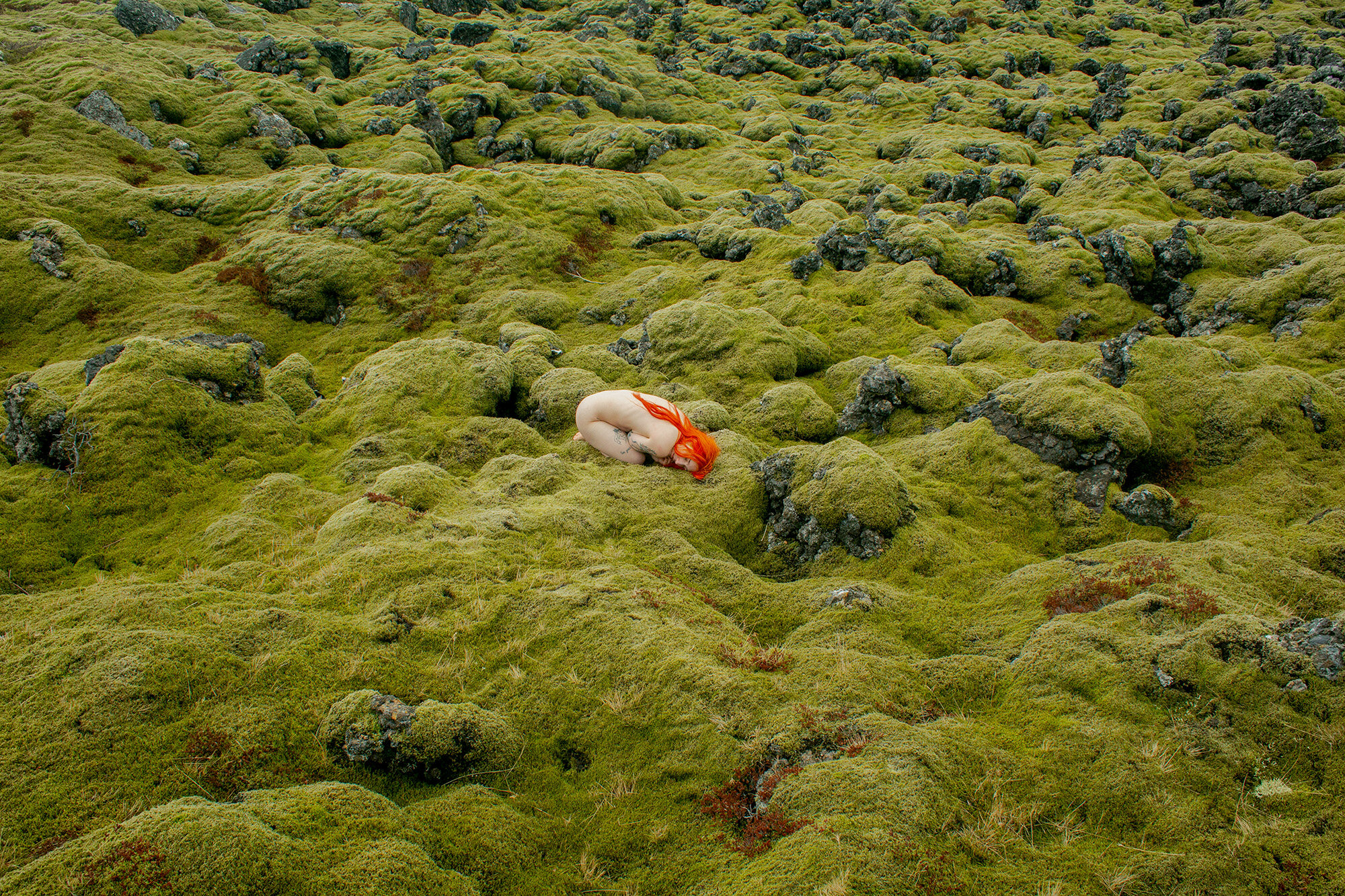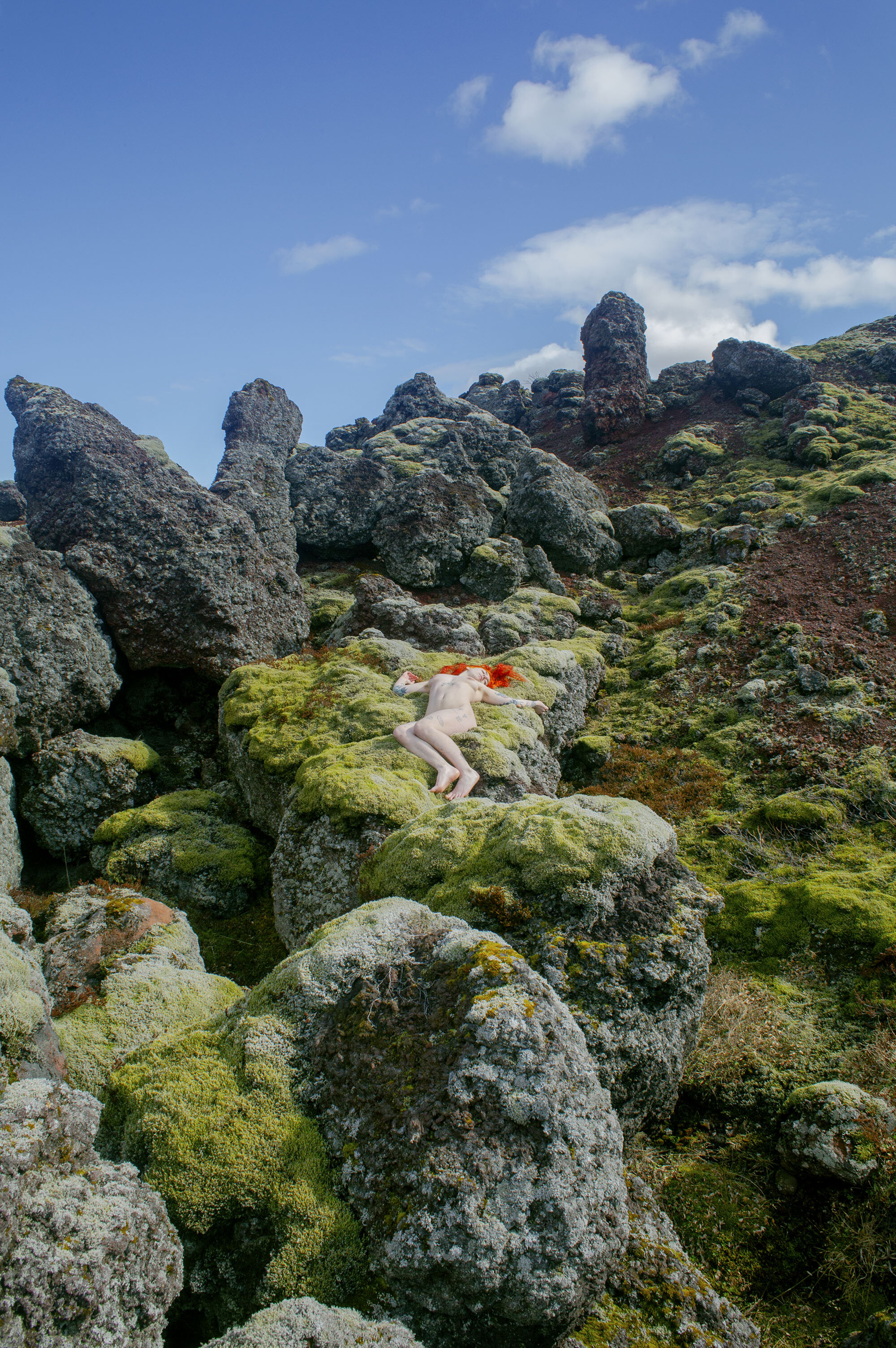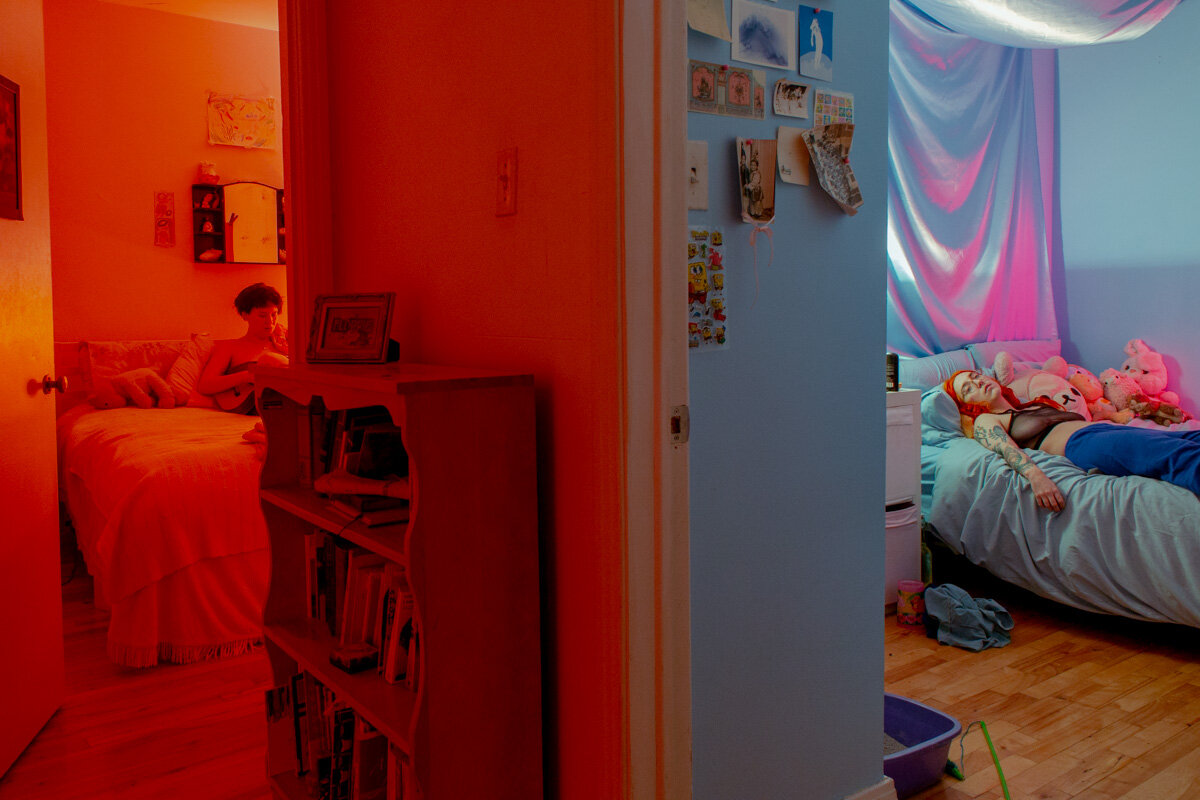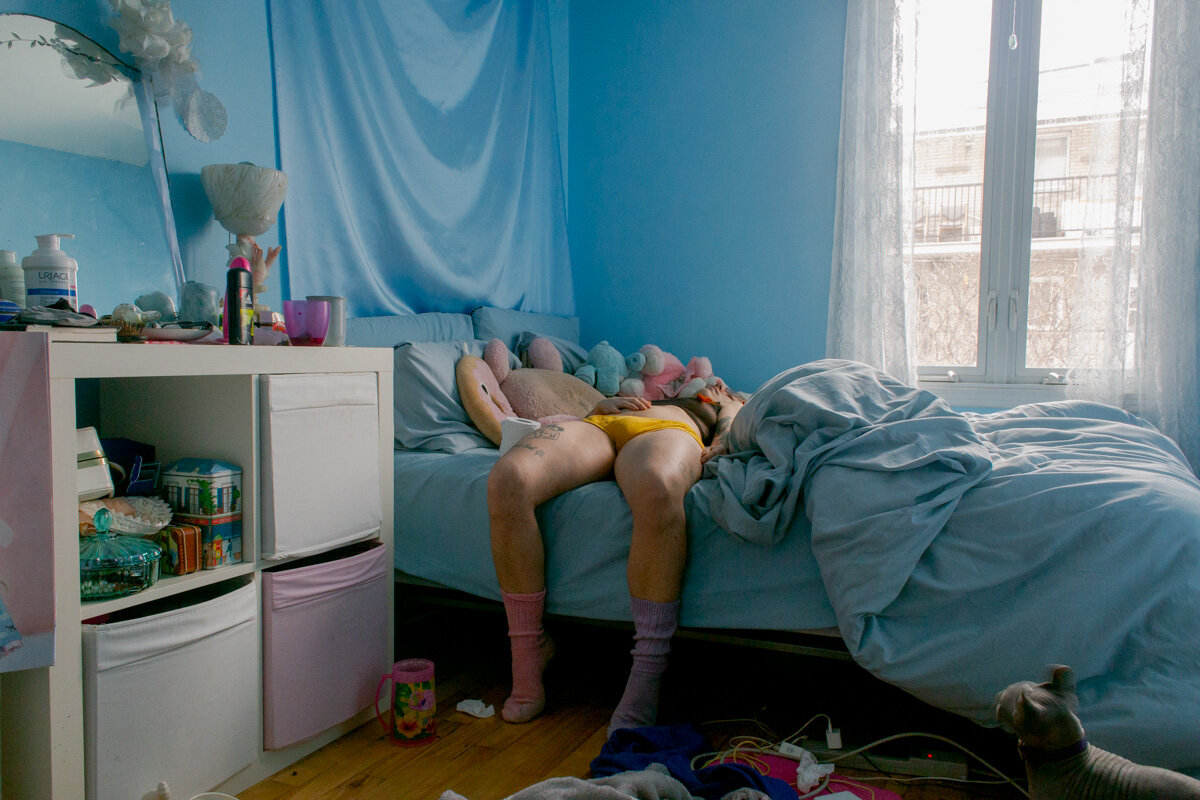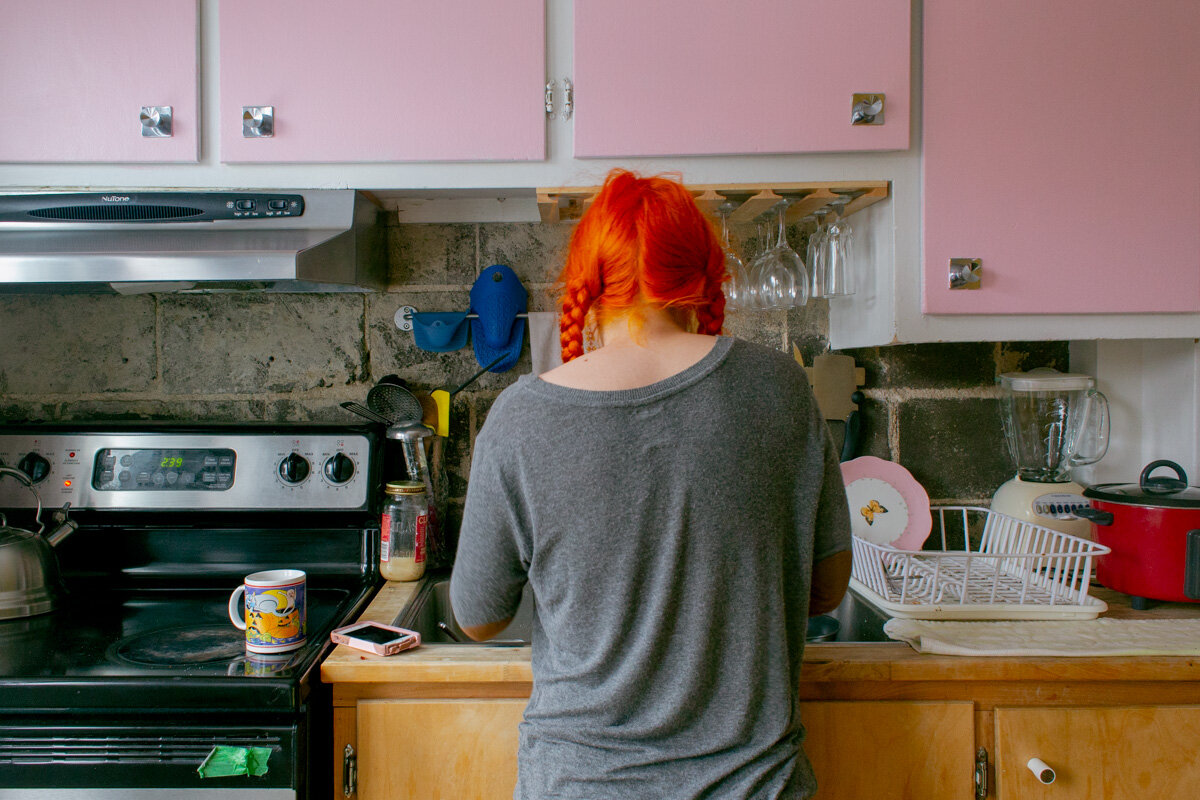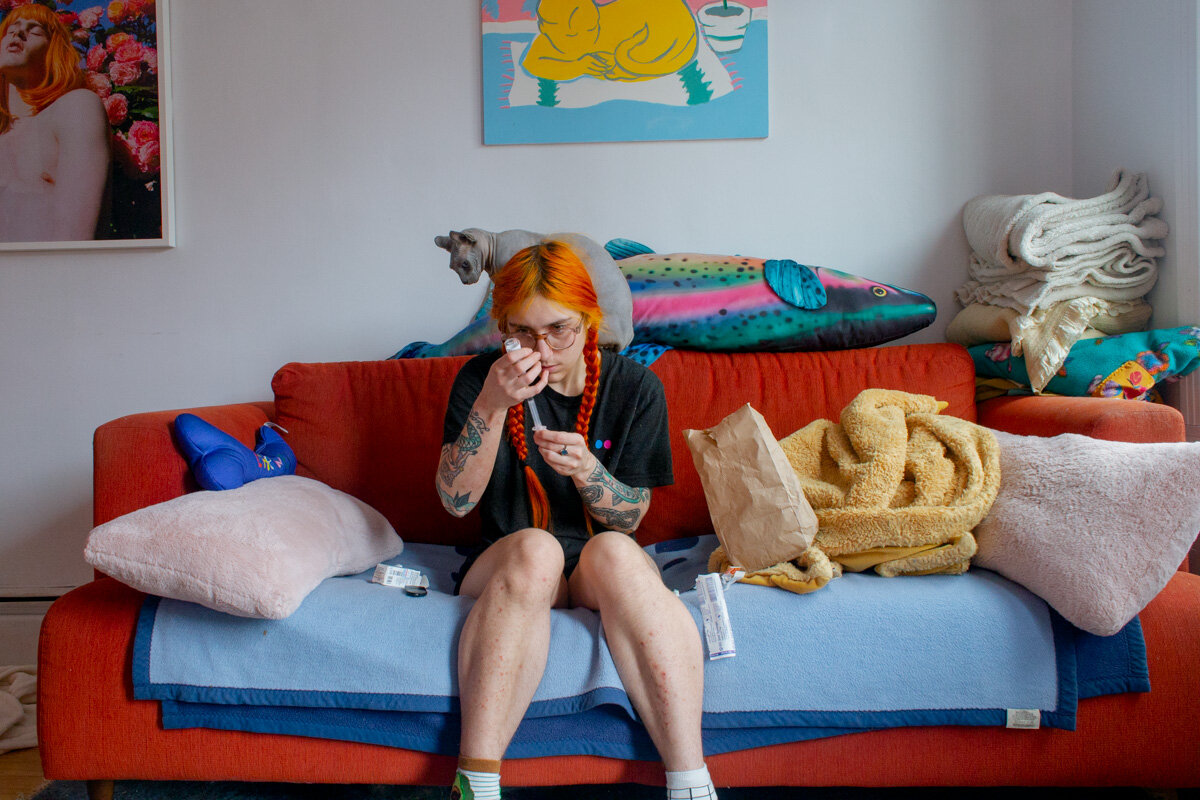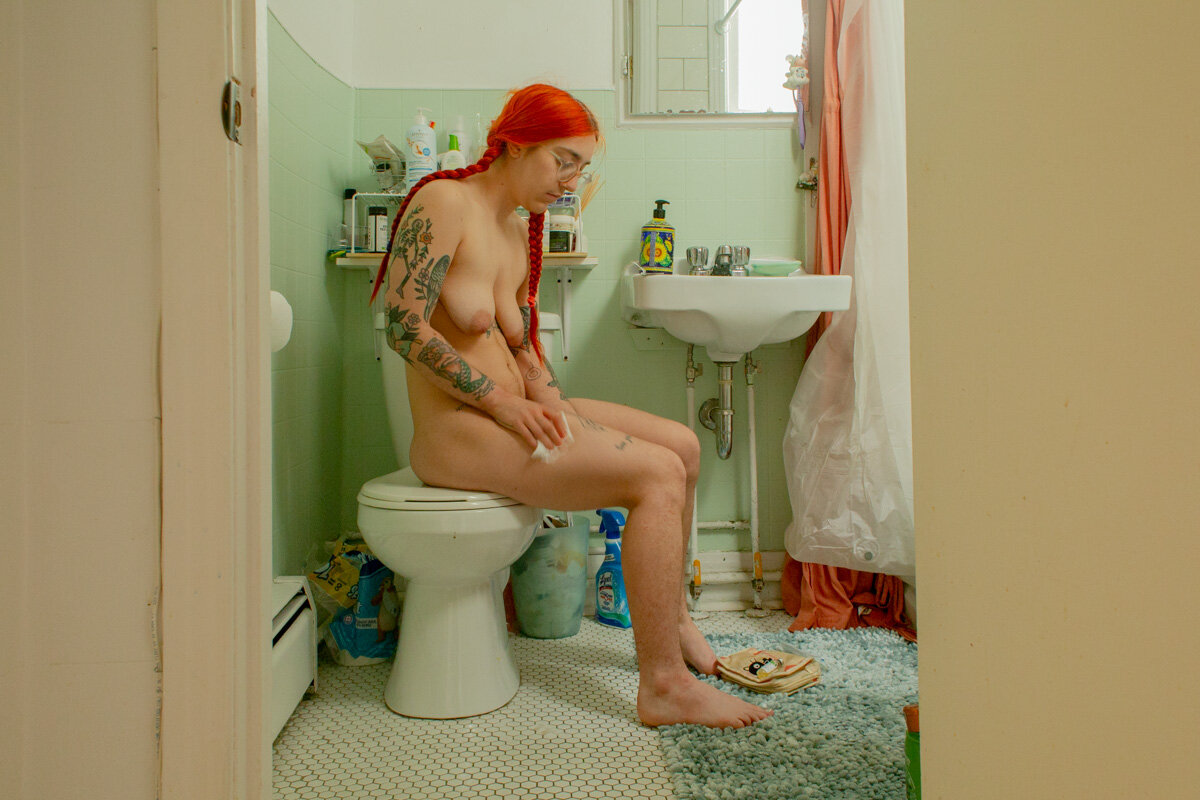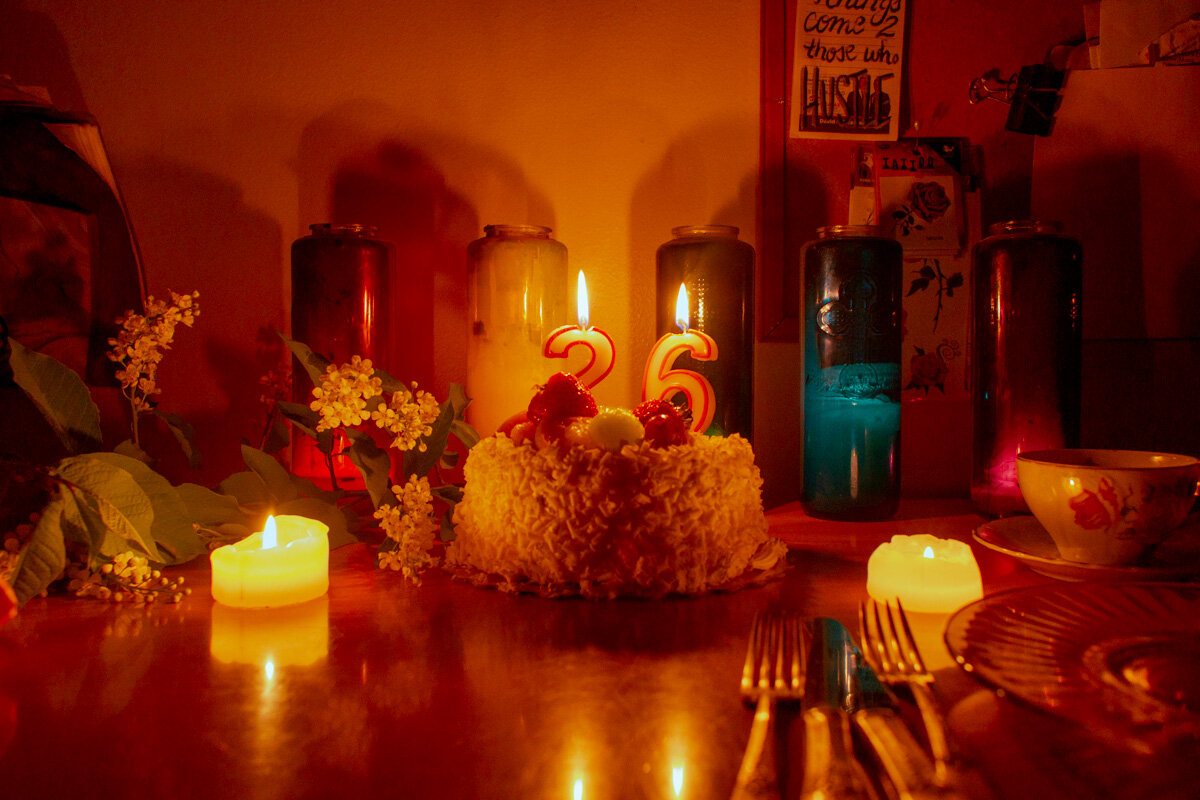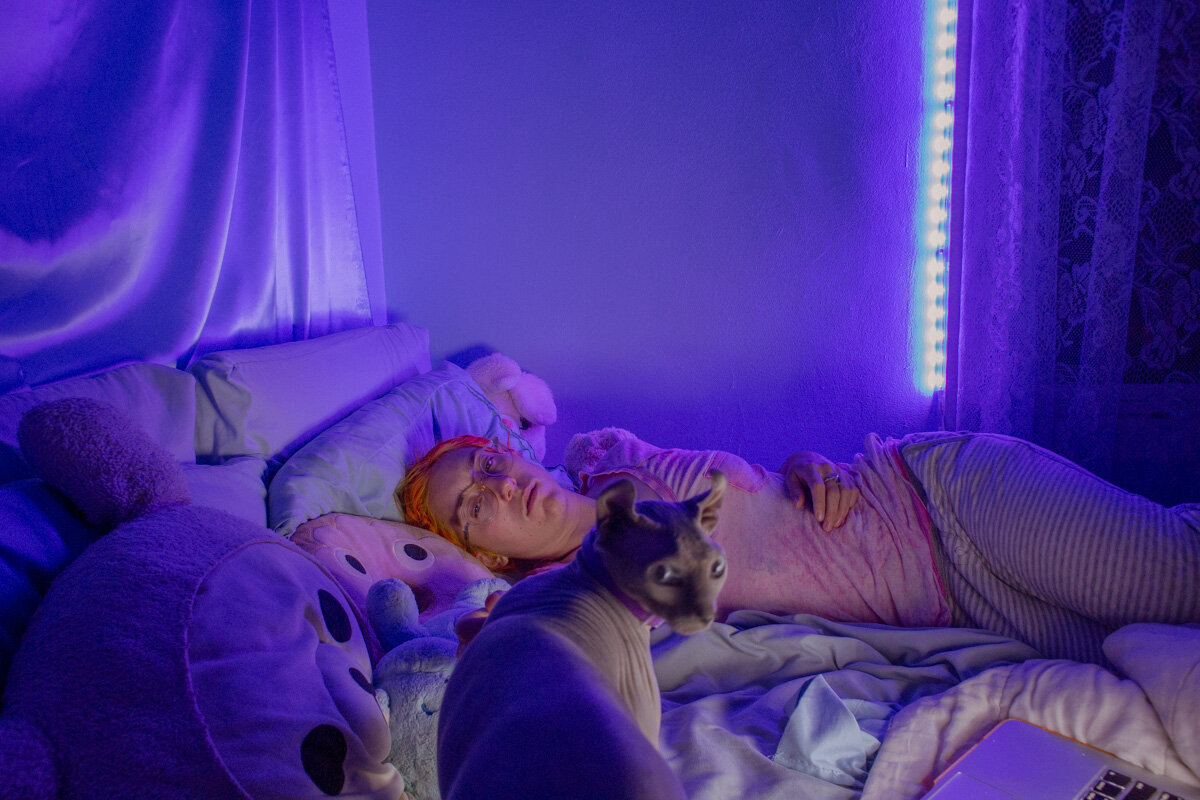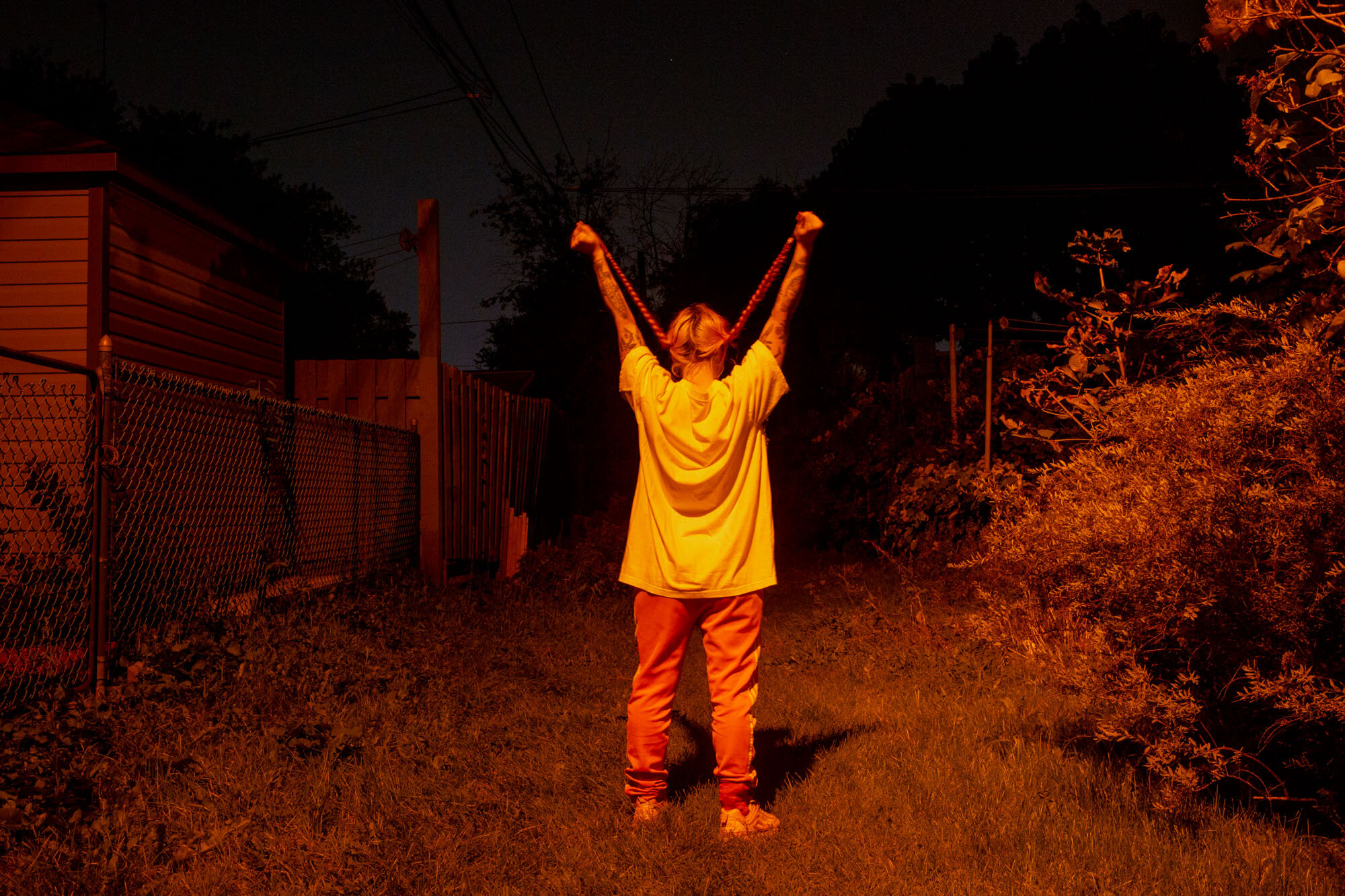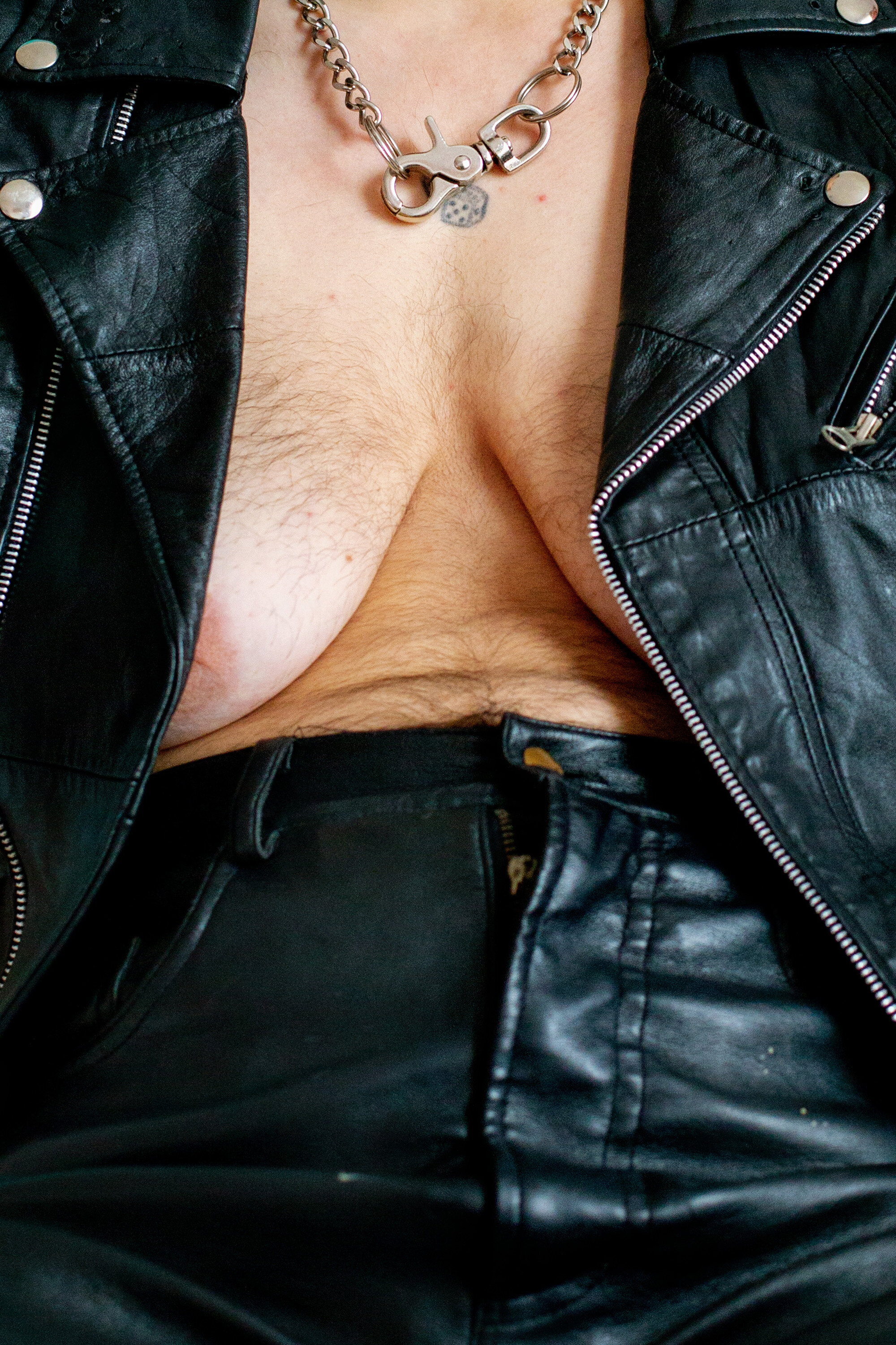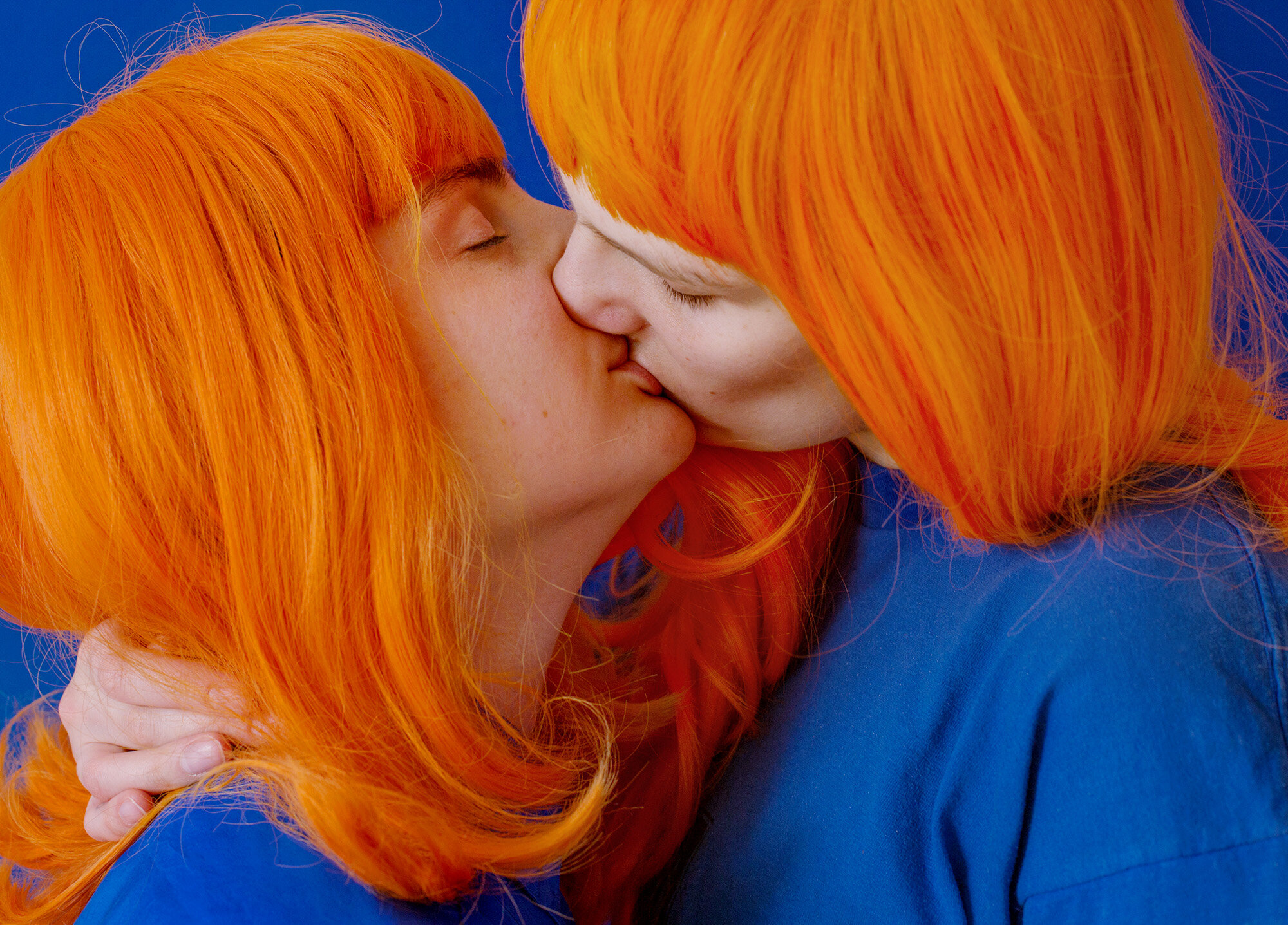Q&A: Laurence Philomène
By Jess T. Dugan | December 5, 2019
Laurence Philomène is a non-binary photographer based in Montreal, Canada. Laurence's work is informed by their lived experiences as a chronically ill transgender artist coming of age amid the rise of social media. Through long-form collaborative and autobiographical projects rooted in care for their community, they aim to celebrate and humanize trans existence. Visually, their work investigates how Western understandings of masculinity and femininity inform our perception of gender, and how the two can co-exist outside of the binary.
Laurence is a recipient of the 2019 Lucie Foundation emerging artist scholarship and the 2020 Women Photograph mentorship program. Their work has been presented in over 40 exhibitions worldwide, including solo exhibits in Toronto, Montreal, Berlin and Kracow.
Jess T. Dugan: Hi Laurence! Thank you so much for taking the time to speak with me today. Let’s start at the beginning: what first drew you to photography, and what was your path to getting to where you are today?
Laurence Philomène: I’ve been obsessed with documenting my life as far back as I can remember, but I was first drawn to photography as an art form around the age of 13-14 when I discovered the work of Gina Garan, a New York-based artist who made several books photographing vintage Blythe dolls. I became obsessed with these dolls and started collecting and photographing them myself. I would share my images on Flickr, where there was a vibrant community of Blythe photographers. This led me to become a part of a wider Flickr community of young photographers, and my focus shifted from just photographing the dolls to also taking pictures of myself and my friends. This was the internet pre-ads, pre-censorship, and there was a real sense of connecting with each other, encouraging each other as we grew as artists, and sharing art just for the sake of it. We’d log on after school and spend evenings chatting about photography, films, and coming up with new ideas. Most of the young artists I shared my life and my work with at the time went on to work as professional image-makers, and many have become world-renowned photographers (Michael Bailey-Gates and Olivia Bee come to mind). Most of us turned out to be queer as well, which doesn’t feel like a coincidence to me. It feels like these are the people I really came of age with.
paint me like one of your pre-raphaelite boy-girls, february 2019, from Puberty
From there, I went to a commercial photography college program (kind of equivalent to a community college or trade program in the USA), where I learned a lot of the technical and business aspects of photography, but it wasn't a space where I was really encouraged to develop a unique artistic voice. During this time, I continued to share my work online (shifting from Flickr to Tumblr), studied all the photo books I could find at my local library, co-founded an online art collective, curated exhibitions – I basically dove into it headfirst and tried everything I could. Around the time I was in school I also came out as queer and became more interested in photography as a space to explore identity.
I graduated in 2014, and have been freelancing since then. I think the key aspects to getting to where I am today have been: access to the internet as a space to share my work and have it be seen, always making personal work a priority, and not giving myself a plan B.
self portrait in abandoned geothermal pool, huldufolk, iceland, 2019
JTD: Could you tell me a little bit about your working process? How do you conceive of a project and what is the process for bringing it to fruition?
LP: All my projects start with me asking myself two questions: What do I want to see in the photo/art landscape that I’m not seeing? And: what story is mine to tell?
From there, projects usually start with trial and error, using my intuition until the project refines itself over time. Most of my projects are long-form and ongoing – I really love working on the same ideas over long periods of time and seeing how these ideas evolve. Doing the same thing over and over until it’s out of my system. I also love having multiple projects going on at once, I have ADHD so that seems to work well for me – I love being able to bounce back and forth between different topics. Most of the time I’ll shoot something, let it sit for a while (sometimes a week, sometimes 10 years), publish bits of it online as I go, exhibit and publish excerpts of it, and then ideally I want to publish all my individual projects in book form – that’s the next step for me.
alexandra as me in yellow room, 2018, from me vs others
JTD: I’m interested in your color palette, which is bold and bright and colorful, and seems to be influenced by – or at least in dialogue with – fashion. What role does color play in your photographs?
LP: I think of colour as an additional visual language in my images, one that complements and adds meaning alongside the subject, composition, location etc. To me the language of colours is more about emotion than it is about fashion – though fashion also uses colour in this way. I also think on a base level, colourful things make people happy. Most of my work is about celebrating marginalized identities, so colour is a great conduit for that message.
I use specific colour based on my gut instinct. There’s nothing particularly rational about it. I also go through phases, which are influenced by everything I’m consuming at any given moment. For example, around 2012-2015 in the Tumblr Years, I was going through a big pastel moment. It was all about reclaiming softness as an anti-capitalist anti-patriarchal thing, but then these colours and ideas quickly got incorporated into the commercial landscape so it lost its meaning pretty fast. Then I dyed my hair orange so I started using that colour a lot into my work. Right now I’m really into bright tones, and specifically into green monochrome. Probably something subconscious about wanting to return to nature and sustainability? More than individual colours, though, what’s important to me is that there’s an interesting conversation happening between the colours that exist in all my images – there needs to be a balance of warm and cold tones in any given sequence.
drinking tea and reading generation wealth, march 2019, from puberty
JTD: Much of your work is autobiographical and includes self-portraits – I’m thinking particularly of your series Puberty, which documents your experience during your transition on HRT (hormone replacement therapy) as a non-binary transgender person. Can you talk to me about the role your own identity plays in your work? What is it like to share your (often very personal) experiences with others?
LP: I became really interested in using photography as a space to play with, explore and dissect identity in college. I was looking at the work of Wolfgang Tillmans, Robert Mapplethorpe, Nan Goldin – artists making autobiographical work. Photography as an identity playground feels like a recurring theme for a lot of queer artists, I imagine because it hasn’t felt as safe for us to explore these things in the real world so art becomes an excuse to look at queerness. Right now my main aim with it really is to create imagery that makes visible and celebrates identities that have been historically marginalized.
On vulnerability: my work has always had a diaristic tendency, though for a long time I kept that part of it more camouflaged. In my series Me vs others, for example, I was making autobiographical self-portraits but shot through other people dressed as me so I was still kind of removed from it. With my project Puberty, where I make daily self-portraits documenting mundane moments during my transition with HRT, I think I’m the most vulnerable I’ve ever been. It was terrifying at first, even just the thought of talking about my transition publicly was unthinkable for my first months on testosterone. Once I took that first step of talking about it with my followers, it felt very liberating – felt good to know that it was all out on the table and that I have nothing to hide. People are receptive to it, too, which always encourages me to keep making the work. I think it creates a space where they recognize themselves and can allow themselves that vulnerability, too, in a way.
taking a bath and doing a face mask, june 2019, from puberty
JTD: In a recent article you wrote for Vice about trans and non-binary representation in photography (which I was happy to be a part of), you wrote about having a powerful experience as a young person discovering representations of queer people in photography books. I had a very similar experience during my teenage years: fine art photography books were some of my first and strongest sources of both validation and inspiration as a queer person, photographer, and activist. I’m interested in your thoughts on the importance of representation, particularly for queer and trans folks (and others who aren’t often represented in mainstream media). How important is the idea of representation to you and your work?
LP: I think the potential issue with representation is having it be the end all be all – there is a rise of trans representation in all forms of media, but at the same time there is also a rise in violence against trans people, particularly trans women of colour & gender-non-conforming people. Beyond representation, I feel what we need the most is right now is education. With that in mind, nowadays most of my work is less focused on just representation but more specifically on humanizing trans lives: showing different facets of our lives, beyond gender presentation. With Puberty, my goal isn’t necessarily to show you what a trans body looks like but to show myself going through daily moments of self care (eating, sleeping, bathing) that connect us all as humans, trans or not. Something else that’s important to me with this work is normalizing the process of HRT by showing what it actually entails, like here is a picture of me doing my shot – so it can be a bit de-mystified for people who aren’t familiar with it. Once people see us as human beings there’s less of a perceived threat, and hopefully less violence.
doing my shot in my bedroom, june 2019, from puberty
JTD: You write that your work is “rooted in care.” I love this idea and think it’s not often expressed or stated so explicitly. Can you expand upon this idea? What are some ways that this idea manifests in your work?
LP: The main way this idea shows up in my work is in the people I choose to photograph. All the people in my work are in my life, often close friends and loved ones. I also tend to photograph the same friends over and over again, so it’s not so transactional, there’s a dialogue there that continues over time. Over the years I’ve also come to prioritize asking people I photograph how they want to be shown, how they seem themselves ideally over my own artistic ideals. The portraits I shoot also often come from a place of wanting to create gender-affirming imagery for the people I photograph, which to me feels like an act of care. I see beauty in everyone, and through making portraits I can make someone see that beauty / love themselves a bit more – that, to me, feels like a super-power.
JTD: Indeed – that’s really lovely. In addition to your personal fine art work, you are represented by Adolescent Content and do assignment/commercial work as well. How do you feel that the two influence or inform one another?
LP: I was once given the advice by a photo agent to always prioritize making personal work because in the end this is what will differentiate me from everyone else who is making commercial work, and I will get hired to make the kind of work that I love. I have found that to be true. I’ve been lucky to mostly do commercial work that relates to what I love doing in my personal work: colourful imagery, work that celebrates queer & trans identities, honest/vulnerable work etc. Through doing commercial work (as well as print sales, portrait sessions and grants) I am able to support making my personal work, so they feed off of each other in that way.
molly soda as me, 2018, from me vs others
JTD: What are you currently working on, and what’s on the horizon for you as an artist?
LP: Currently, I’m about to embark on my second year shooting daily self-portraits for Puberty, so that is taking up most of my time. I’m also continuing work on multiple long-form projects, especially Lucky, which is a 10-year documentary project with my best friend, looking at transition over a long period of time, as a theme in many aspects of their life as an intersex / trans masculine / survivor / community worker / person. I’m also hoping to put together and publish a book of a self-portrait project I shot in Iceland last year titled Huldufólk, and I’m releasing a smaller project documenting queer punk subculture in Montreal. I’m also taking part in the Women Photograph mentorship program, which I am super excited about, because as a queer photographer in a small(er) city, I haven’t had many real-life mentors to look up to so I’m excited to see where that takes me!!
JTD: Great, thanks so much Laurence!
self portrait at sulfur rock, huldufolk, iceland, 2019
All images © Laurence Philomène








